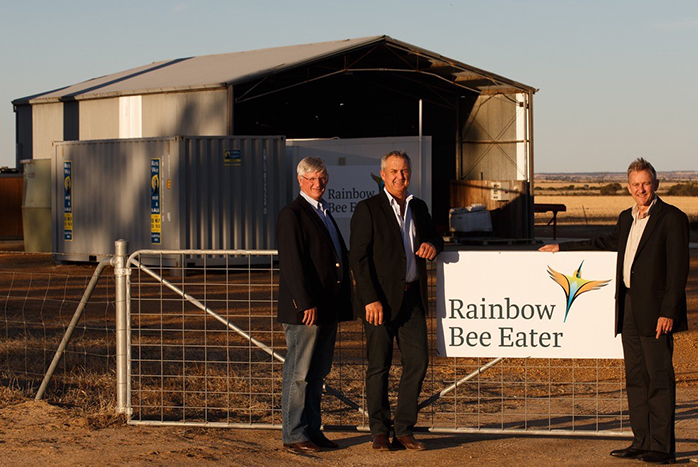We use cookies to give you a better experience on our website. Learn more about how we use cookies and how you can select your preferences.
Rainbow Bee Eater – Using 21st century thinking to turn agricultural waste into clean energy

100% of our funding goes to R&D. At the start, this was mostly self-funded equity. Getting equity is hard and getting industry involved is very hard… the R&DTI has kept us in business.
Company Profile
Company: Rainbow Bee Eater
Sector: Electricity, Gas, Water and Waste Services
Location: Victoria
Profile: Rainbow Bee Eater is developing a revolutionary technology to help communities and businesses manage biomass waste, produce energy and reduce their carbon footprint.
Why R&D is needed
Rainbow Bee Eater helps communities and industries use biomass to produce energy, which also reduces Australia's dependence on fossil fuels.
Biomass is an affordable, sustainable energy source. Biomass includes cereal straws, wood chips and shavings, green, food and animal wastes. Currently, only 1% of Australia's energy comes from biomass. With the right technologies, it’s estimated that this could be as high as 30%.
Farmers, scientists and engineers came together to establish Rainbow Bee Eater, with $750,000 in initial funding provided by Alumina Ltd in 2007. The company used this funding to research existing biomass technologies around the world, to identify the most economic and environmentally friendly options for producing sustainable power.
Rainbow Bee Eater identified a gap in the market — no existing processes or technologies could reliably produce the low-cost clean fuel gas called Syngas used to produce energy from biomass.
Managing Director Peter Burgess says travels to Japan, USA, Canada and Western Europe also demonstrated that existing technologies required government subsidies. Relying on subsidies wasn’t a sustainable long-term business model.
“We wanted a technology that could stand on its own…the existing systems required expensive technologies to clean up the fuel gas. So the problem to be solved was — how can we make a simple, affordable process that produces Syngas,” Mr Burgess said.
After the global financial crisis, the company lost its funding from Alumina Ltd. Founders used their own equity to continue their R&D efforts, with some later support from the Costa Group.
“After several years of testing various technologies, we still believed that none seemed capable of reliably producing low-cost, clean Syngas. So we decided to develop our own system.”
After 9 years of R&D, the founders' efforts paid off. Rainbow Bee Eater successfully developed the ECHO2 technology, which produces low cost, base-load fuel gas or electricity from biomass.
All that's needed for energy production is sustainable biomass residues like straw or animal waste. These residues are put in to an ECHO2 unit. What comes out is Syngas and charcoal, also known as biochar.
“ECHO2 does the complete conversion to clean Syngas in one simple process. It converts the solar energy stored in the biomass residues into a different form of energy that we use to generate electricity, heating and refrigeration.”
From an environmental and energy perspective, this is a win-win. The Syngas — a mixture of hydrogen, methane, carbon monoxide, carbon dioxide and nitrogen — is clean and strong enough to be used in applications that need combustible gas, such as high-efficiency gas engines for generating electricity, and high-efficiency boilers and chillers.
The biochar by-product can be used in agriculture, horticulture, building materials, and in many other applications. Biochar is also good for gut health, speeds up organic composting processes and improves the nitrogen balance in soil.
The overall process is environmentally friendly. Energy production from biomass generates renewable energy, and removes carbon dioxide from the atmosphere for anywhere up to thousands of years. The carbon that is absorbed in the process is stored in the biochar.
Following on from its prototype ECHO2 unit, in 2017 the company secured its first commercial sale - a $1.4 million turnkey unit for the Holla-Fresh herb growing company in Mt Gambier, South Australia.
‘This will be delivered in early 2018. It is a fully-automated unit that will convert wood wastes into hot water, electricity and CO2 for the Holla Fresh glasshouse,’ Mr Burgess says.
How the Research and Development Tax Incentive helps
Mr Burgess says the R&DTI has allowed Rainbow Bee Eater to investigate, develop and commercialise its ECHO2 product. The company now has several other potential customers.
One of these is a very large woodchip port where there is interest in using wood chip fires to provide local power and heat. The other is a large poultry farm. Both of these companies have unused waste that can be used as biomass for ECHO2.
Mr Burgess says any business or community using purchased power and LPG or natural gas for heating and which has a supply of low-cost biomass may find that the ECHO2 technology has significant financial, environmental and social benefits.
We've had 10 years of support from the R&DTI. This gives us credibility.
-
For more information, visit Rainbow Bee Eater's website.
Rainbow Bee Eater